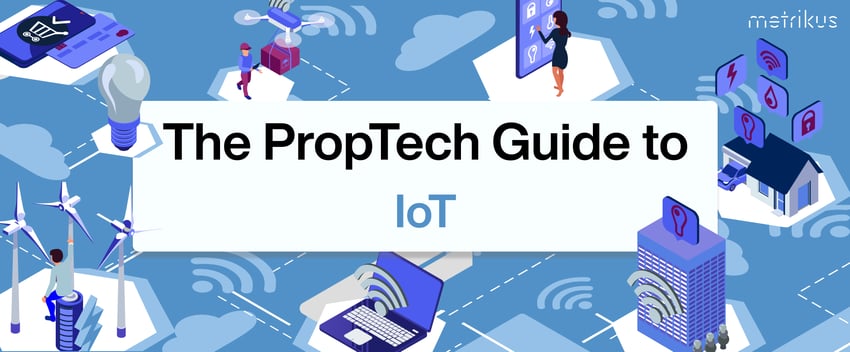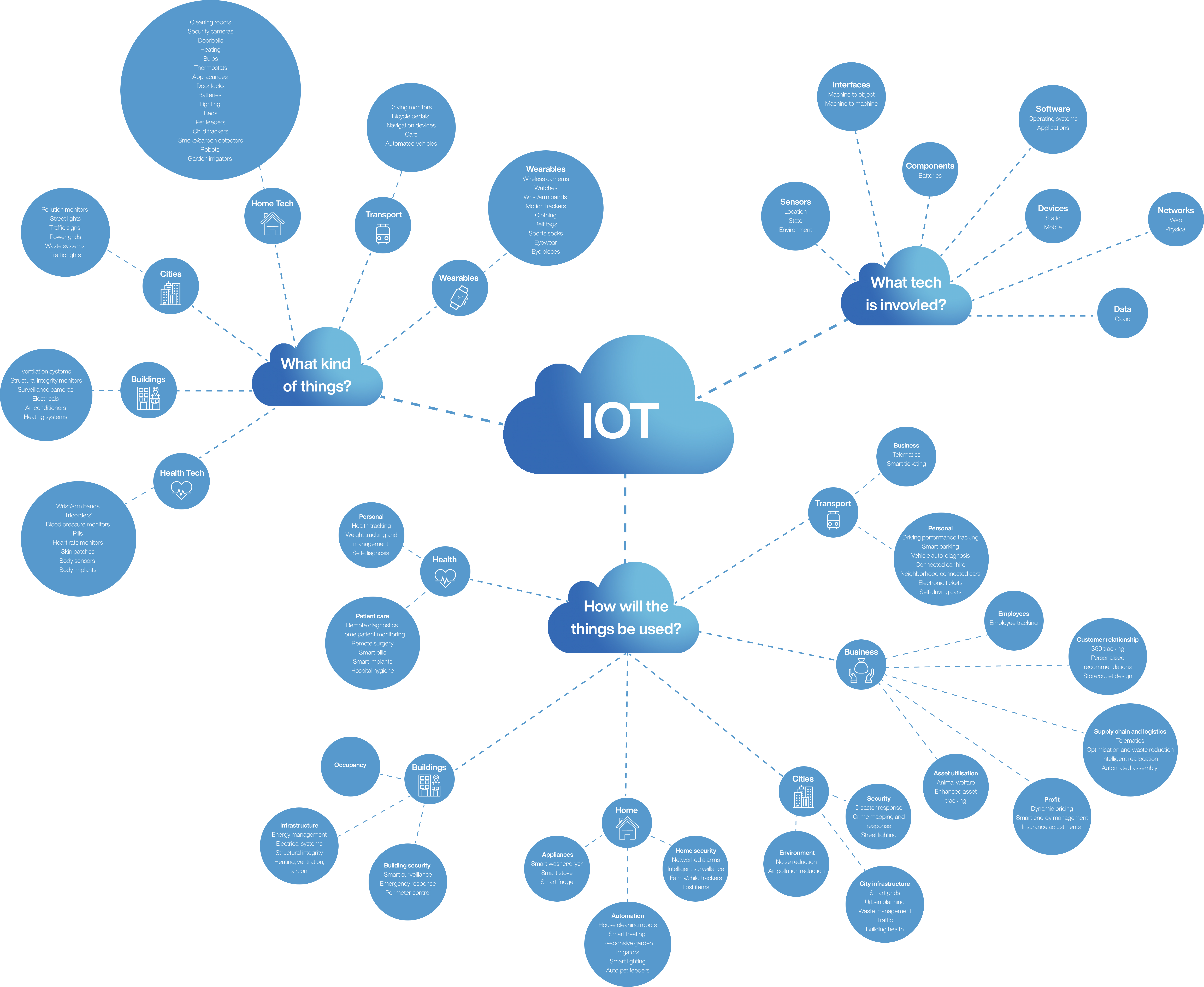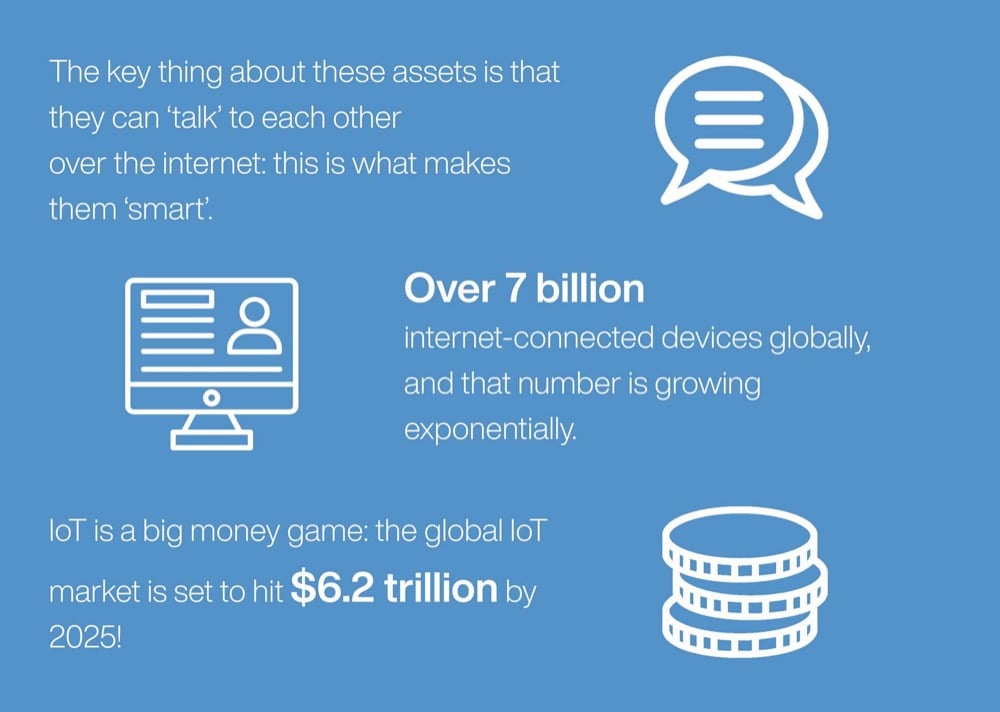What is the Internet of Things? Ultimate guide to IoT
Check out our full IoT infographic here.
What is IoT (Internet of Things)?
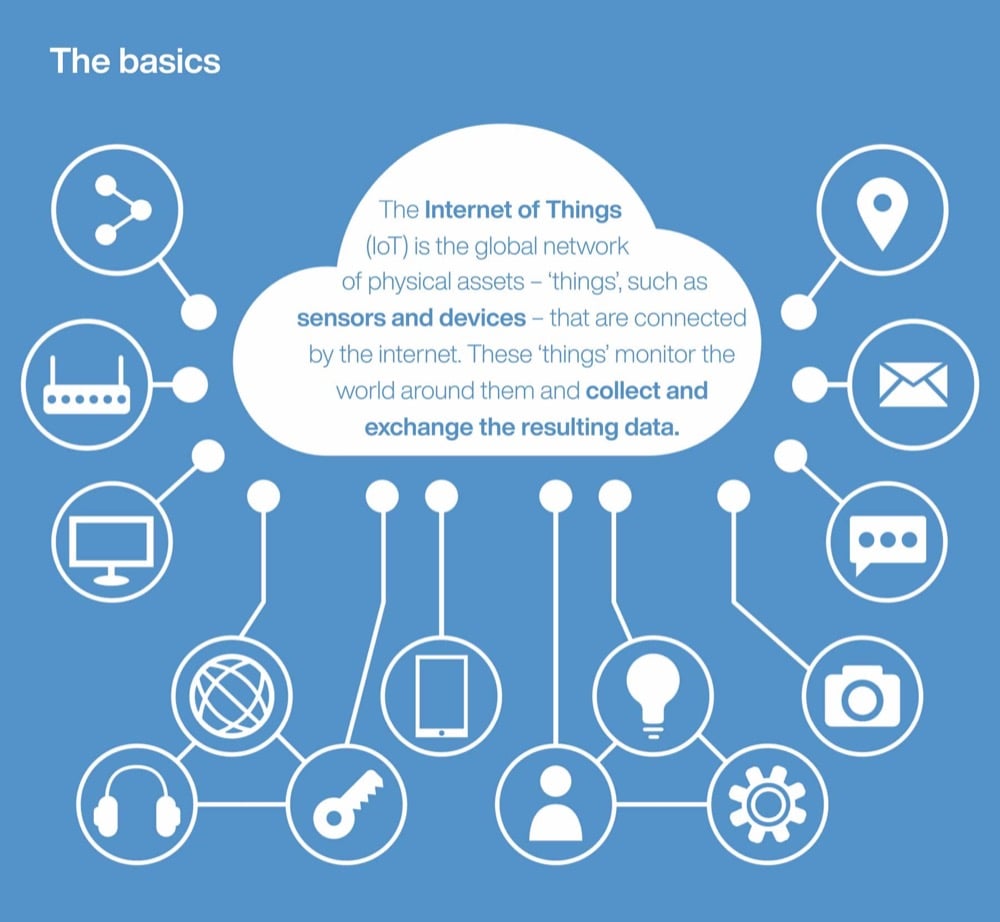
A simple explanation of IoT
The Internet of Things (IoT) is the global network of physical assets – ‘things’, such as sensors and devices – that are connected by the internet. These ‘things’ are used to monitor the world around them and to collect and exchange the resulting data.
The key thing about these assets is that they can ‘talk’ to each other over the internet: this is what makes them ‘smart’. Some ‘things’ collect and send information, some receive information and act upon it, and some can do both. The data that is collected and analysed by IoT can help us make more informed, efficient and meaningful decisions.
Technically, any device connected to the internet is part of the Internet of Things. According to data from IoT Analytics, there are over 7 billion internet-connected devices, and that number is growing exponentially.
And this is a big money game: the global industrial IoT market size was estimated at $320.9 billion in 2022 and is expected to hit around $1,562.35 billion by 2032.
What ‘things’ are in the Internet of Things?
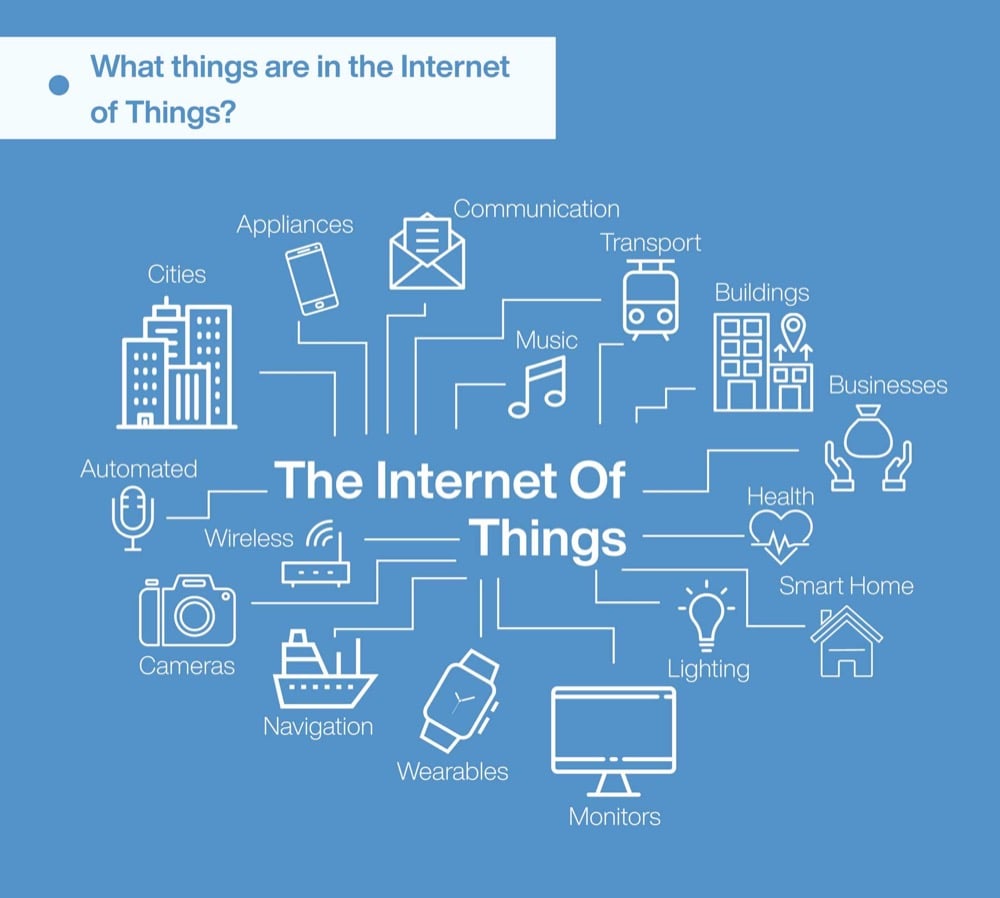
When it comes to monitoring, collecting and sending data, we’re mainly talking about sensors, but many other ‘things’ can come into play, like CCTV cameras, blood pressure monitors and even baby monitors.
What is an IoT platform?
An IoT platform connects the data from all of your sensors and devices in one place. It doesn’t matter how many sensors, devices or other gizmos you have – unless they’re connected and visible on an IoT platform, they’re pretty much useless.
Let’s look at what is needed for an IoT platform:
1. Hardware
These could be sensors that collect data or devices that perform actions.
2. Connectivity
The hardware can transmit data to the cloud or receive messages in a number of ways: cellular, satellite or WiFi connectivity are common, but IoT-focused options like LoRa are becoming more popular.
3. Software
Software analyses the data collected from the sensors and makes intelligent decisions. It’s hosted on the cloud.
4. User interface
A user interface is vital, so that users can interact with the IoT platform.
How do sensors and devices connect to IoT platforms?
Well, there’s a couple of ways: sensors and devices can be connected directly to the cloud or indirectly via a local gateway (edge device).
Both devices and gateways can implement edge intelligence capabilities. This allows for the aggregation and reduction of raw telemetry (remote) data before it’s transmitted to the backend. It also allows for local decision making capabilities on the edge.
Here are the main device connectivity options:
1. Direct device connectivity to the cloud gateway: this one is for IP capable devices that can establish secure connections via the internet.
2. Connectivity via a local gateway: short range communication technologies suitable for sensors/devices using industry-specific standards, as well as resource constrained devices incapable of hosting a TLS/SSL stack. This option is also useful for aggregation of data at the edge.
3. Connectivity via a custom cloud gateway: this is for devices that require protocol translation or some form of custom processing before reaching the cloud gateway.
4. Connectivity via a local gateway and a custom cloud gateway: similar to previous, but also with some functionality performed at the edge.
Why do we need IoT?
We can use these technologies to improve experiences, improve efficiency or improve safety. With so many billions of things being connected, the possibilities for improvement are endless.
As we will see, IoT is invaluable not only to big business but also in the home, in healthcare and even in agriculture. The connected nature of IoT devices in many cases can make many tasks easier, simpler and less prone to human error.
We’ll go into smart environments in more detail later, but for the moment let’s take a look at all the reasons why IoT is great for businesses.
How is IoT useful for businesses?
1. Real-time collection of big data
IoT devices can collect and store enormous amounts of data in real time, and they’re designed to do this without crashing your systems.
2. Automated data analysis allows rapid reaction
Utilised to the best of their abilities, IoT systems can help you have a full view of your assets, products or how your service is operating, giving you the opportunity to react rapidly and to make changes based on customer behaviour.
3. Cost-effective solution
The data collected from IoT devices can be analysed rapidly by other connected devices, mitigating the need to pay an expensive salary or hire a consultant. Sensors accompanied by monitoring software can also reduce the cost of running your office, whether by lowering energy costs or by making it clear that you could downsize your space.
You can read more about this in our blog post on How IoT Can Improve Your Bottom Line.
4. Makes remote working easier
IoT allows teams to work collaboratively and to share data and documents wherever they are in the world.
5. Occupancy monitoring
This one is crucial right now and we’ll go more into it later. Occupancy monitoring can help you ensure your space is meeting government guidelines on social distancing, even if you’re working from home.
6. Air quality monitoring
Monitoring the quality of your air is important even when we’re not in the clutches of a pandemic: high C02 levels have been shown to dramatically reduce cognitive function. If you want to know more, we’ll delve deeper into air quality monitoring further down this article.
For more on IoT and business, take a look at our blog post on IoT and the retail industry.
A brief history of IoT
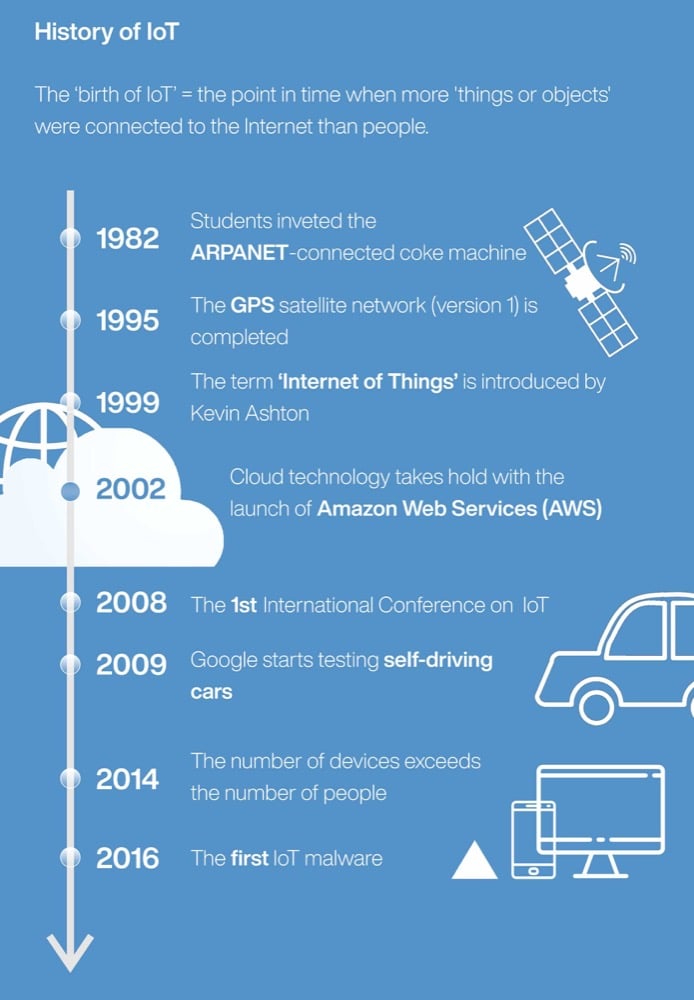
The phrase ‘Internet of Things’ was coined in 1999 by Kevin Ashton of the Auto-ID Centre, when he noted that the problem they were working on was how to expand the scope of the Internet to include Things. In 2002, Ashton said:
“This is the next 50 years of computing. This is not a small thing. This is as significant a technology as, certainly the Internet, possibly the invention of the computer itself”.
The ‘birth of IoT’
Cisco Systems has defined the birth of IoT as ‘simply the point in time when more 'things or objects' were connected to the Internet than people’, estimating IoT’s birthday as somewhere between 2008 and 2009.
To put this into perspective, Cisco’s whitepaper showed that the things:people ratio grew from 0.08 in 2003 to 1.84 in 2010. But nothing’s ever that simple – the history of IoT goes way, way back.
The story of the first IoT device
It may not be surprising to find out that the first true IoT device was borne from frustrated graduate students not getting what they wanted when they wanted it. In this case, the students were at Carnegie Mellon University in the early 1980s, and all they wanted was an ice-cold Coca Cola.

As the story goes, David Nicholls, graduate student, was working away in his office when he suddenly got a craving for a Coke.
The only problem? His office was ‘relatively far’ from the nearest vending machine, and he was pretty sure once he trekked over there he’d face one of two equally terrible situations: the vending machine would either be empty or only recently refilled, leaving him with a warm and deeply unsatisfying drink.
Nichols mulled this over. “Suddenly, I remembered tales of the Prancing Pony [the first computer-controlled vending machine] at Stanford and realized that we didn’t have to put up with this, that we had the technology,” he later recalled.
The IoT Avengers assembled: together with Mike Kazar and Ivor Durham, fellow graduate students, and John Zsarnay, a research engineer, Nichols put his mind to this tricky, but ultimately solvable problem.
The key lay in the vending machine’s light system. There were six lights, each corresponding with one of the six columns of Coke bottles. When a bottle left the vending machine, that column’s light would flash momentarily before turning off again. When the column was empty of bottles, the light would stay on until they were replaced.
Zsarnay, the team’s resident research engineer, installed a sensor board into the vending machine to track the lights, which connected to the ARPANET (the Advanced Research Projects Agency Network, a technical foundation of the internet we know and love).
We may have made this sound straight-forward, but in reality it was anything but: the very first version of the board actually caught fire when it was installed into the Coke machine!
The program Kazar concocted was, he says, pretty simple: it checked the status of each column’s light every few seconds, knowing that an on/off flashing light meant a drink had been bought, and that if the light stayed on then the column was empty. The machine always held two cold drinks in backup, so when the light went back off the team knew that those two cold ones were ready while the rest were warm.
How did they know when they were chilled and ready? Three hours after restocking, the program showed those bottles as ‘cold’.
And thus was born the first IoT device. The team didn’t just keep this to themselves – the altruistic scientists set the system up so that anyone with access to the ARPANET or Carnegie Mellon’s local Ethernet could keep track of the Coke situation and get themselves an ice-cold beverage, no wasted trips in sight.
Want to know more? You can read the story first internet-connected device right from the horse’s mouth here.

The more recent history of IoT
In their article on the history of IoT, Verdict discusses the progress of the Internet of Things:
‘Originally billed as a way for businesses to better manage their supply chains, businesses really started to get excited about IoT in the early 2010s, much like the anticipation surrounding artificial intelligence that is being experienced now. The history of IoT, at least as we now know it, starts around here.’
They continue by noting that ‘the emergence of companies such as Nest Labs, the creator of the Nest smart thermostat, and the continued investment in personal assistant technology by US tech giants such as Amazon and Google,’ has really brought IoT to the forefront in recent years.
A quick look at Google Trends shows the development of interest in IoT since 2016. The 2018 peak seems to have generally continued, although the recent dip in searches since February 2020 could be due to widespread lockdowns and the general halting of industries worldwide.

Want to find out more about how IoT has progressed? Check out our post exploring ten of the most bizarre IoT-connected devices we have ever come across.
Digital Twins
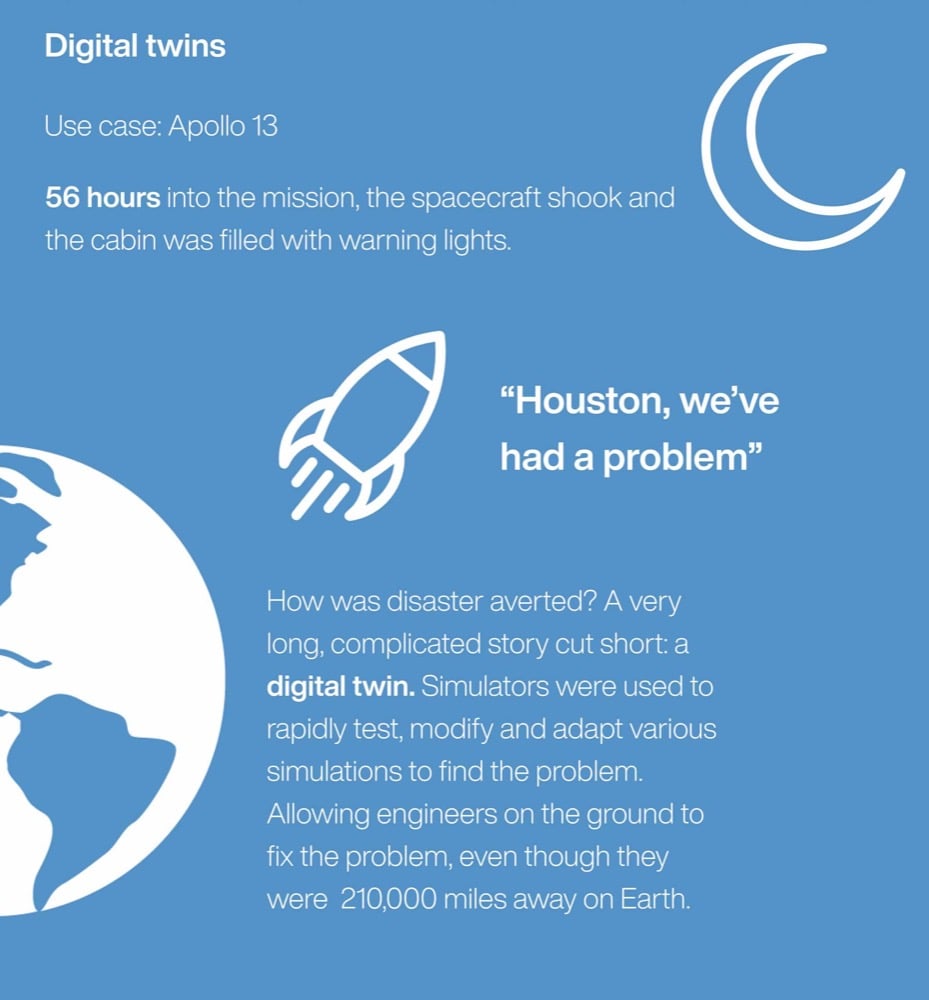
What is a digital twin?
Put simply, a digital twin is a virtual copy of a physical asset or object: it could be a building, a car or even a rocket.
A digital twin enables your operations to shift to a new level of efficiency. In the next section, we’ll discuss smart offices and show how at Metrikus we use a digital twin to monitor our own office space.
The first digital twin
Although the phrase ‘digital twin’ was used by Michael Grieves at the University of Michigan in 2002, the concept has been around a lot longer than that.
Perhaps unsurprisingly, NASA was the pioneer in what was then known as ‘pairing technology’, the gateway to the digital twins we know today. The technology was developed back in the early days of space exploration as NASA grappled with the problem of how to maintain and fix systems that were far beyond the reaches of their scientists and engineers.

56 hours into the Apollo 13 mission, disaster struck. The astronauts didn’t know it at the time, but there was a fire in their oxygen tank. In fact, a massive part of the problem was because the crew couldn’t see inside the area where the issue was. 210,000 miles away, Mission Control was working on it. Using 15 simulators – digital twins of the Apollo 13 – they went through numerous simulations to isolate the problem.
Disaster was averted during the 1970 Apollo 13 mission as this paired technology allowed engineers back home to study systems on board in order to figure out how to save the mission (spoiler: they may not have reached the Moon, but the crew were returned safely to Earth and the mission was deemed a ‘successful failure’).
These days, digital twins aren’t only being used in space. John Vickers, principal technologist at NASA’s National Center for Advanced Manufacturing explains that ‘the ultimate vision for the digital twin is to create, test and build our equipment in a virtual environment.’
He continues, ‘only when we get it to where it performs to our requirements do we physically manufacture it. We then want that physical build to tie back to its digital twin through sensors so that the digital twin contains all the information that we could have by inspecting the physical build.’
Smart environments

Smart technology is everywhere: in our homes and offices, across whole buildings and even throughout cities.
There’s a lot of confusion about smart environments and buildings out there. People may picture futuristic spaces, covered with NASA-grade materials and rooms lit up with bells and whistles.
But the reality is much simpler than that. A smart building can be very technologically sophisticated, but at the heart of it, it’s simply a building that collects and utilises data from a system of sensors and devices.
Through the power of IoT, all those systems can talk to each other to automatically optimise the way the space works, for example cooling down a room that gets too hot, flagging an alert when the occupancy of an office is too high, or reusing energy across a building.
Smart homes
Home automation has become increasingly popular, with systems to control home security, entertainment systems and the indoor climate amongst many others. At the heart of it, smart home technology is designed to increase comfort, ease, efficiency and safety.

The Department of Trade and Industry defines a smart home as ‘A dwelling incorporating a communications network that connects the key electrical appliances and services, and allows them to be remotely controlled, monitored or accessed’ (remotely, they note, refers to both inside of and outside of the home).
So how do you make your home smart? The good news is, you don’t need to have a fancy new build to avail of this technology: homes can very easily be retrofitted.
The Department of Trade and Industry outlines the three things needed to make a home smart:
1. Internal network
- Wire, cable, wireless
2. Intelligent control
- Gateway to manage the systems
3. Home automation
- Products within the homes and links to services and systems outside the home
There are six main areas of appliances and services that make a home smart:
1. Environmental
- Heating/water, lighting, energy management, metering
2. Security
- Alarms, motions detectors, environmental detectors
3. Home entertainment
- Audio visual, Internet
4. Domestic appliances
- Cooking, cleaning, maintenance alerts
5. Information and communication
- Phone, internet
6. Health
- Telecare, home assistance
Not too long ago, the idea of a smart home may have been a fantastical one. Remember Mike Kazar, one of the Carnegie Mellon Coca Cola heroes? He said when he was a grad student in the ‘80s, the head of CMU's Computer Science department would often talk about how ‘in the future, your toaster will be on the Internet’. But even the people who built the first IoT device didn’t take that too seriously: ‘many of us thought it was a joke’.
In fact, he shared this cartoon with us that ‘pretty much summed up [their] expectations for IoT’:

People aren’t laughing anymore – here’s a smart toaster you can buy for just £59.99.

On a more serious note, smart home technology isn’t always a gimmick: it can actually be really helpful. Gone are the days of worrying about leaving things on or coming home to a cold house when you can control lighting, appliances and thermostats from anywhere via your mobile phone.
It’s not just about when you’re out, either: Amazon Echo and Google Home are the major players in the voice assistant game, and can help you to time your pasta, turn the lights down when you’re on the sofa or turn up the volume at your party. Products like Ring Video Doorbell and smart locks can enhance the security of your home. In many cases, these systems can all connect to each other, too, making life easier than ever: IFTTT helps immensely with these connections – and they do it for free!

IoT-enabled appliances can also help your home be greener, from managing heating and electricity while you’re away to fridges that show you what’s inside with just a double knock, reducing the loss of cool air (these solutions are pretty cost-effective too, and who doesn’t like saving money?).
Smart homes, IoT and Indoor Air Quality
One really important trend at the moment is indoor air quality.
The WHO estimates that we spend up to 90% of our time indoors.
Maintaining good air quality within our homes is vital, and IoT could play an important role in many households.
When the days get colder and we turn our heating up, the humidity in our homes is prone to drying out the mucus membranes that line our airways and that are vital to help our bodies defend against colds, flus and other viruses.
Furthermore, as we now know that the Coronavirus is commonly spread via aerosol particles, it’s really important to keep spaces well ventilated.
Having an automated system that tracks the quality of the air, linked with a high-grade filtration system or purifier that responds accordingly is an ideal solution.
Where such systems and/or air purifiers aren’t possible, opening windows and using a humidifier or even just boiling water on the stove can do the trick. Check out this article by AirRated about how you can make low-cost changes to improve your IAQ.
Things to consider when connecting your home
Forbrukerrådet has put together some helpful thoughts that you should certainly consider when buying smart technology for your home:
- Who owns the enormous amount of data that these sensors collect, and how is this information being used?
- What can you do if the service linked to the connected device shuts down, making the device stop working as intended?
- Will it be possible to purchase products from competing companies without having to maintain two or more “eco-systems of things”?
- If a service-provider thinks that you are in breach of their terms of service, do you risk being shut out of the entire “eco-system” of your home?
Smart offices
Using IoT to create smart offices can help workers be healthier, more comfortable and even more productive. Don’t work in a brand new office already kitted out with top-of-the-range sensors? Retrofitting an office to make it smart really doesn’t have to be complicated.

Take the Metrikus office for example: we have sensors all over the office monitoring occupancy, legionella, light and air quality including CO2, PM2.5, TVOCs, NO2, O3, CO, temp and humidity (check out our blog post about the key indoor air quality parameters). It’s a smart office, but you hardly notice the components that make it one.
On our dashboard we have a complete digital twin of our office that shows us data from all of those sensors in real time. It’s been unbelievably helpful for us during this pandemic, as it’s allowed the whole team to keep an eye on occupancy remotely.
Back to the evidence surrounding the coronavirus and air quality – being able to monitor our humidity, temperature and CO2 and keep them all at optimal levels means we know our space is healthy for our team.
We are just one small office, but having a digital twin with all the data in one place makes it really easy to monitor a space like this, a whole building or even an estate.
Ready to make your office work smarter, not harder? Get in touch today for a demonstration.
Smart buildings
It’s not just homes and offices that can utilise IoT to be their smartest selves – entire buildings can be fitted out to become safer, more efficient, and just generally more enjoyable to spend time in.
Smart buildings simply use automation to optimise any number of processes. These could include:
- Ventilation
- Heating
- Cooling
- Lighting
- Security
- Water usage
For those who might be put off by the upfront cost of retrofitting their building or estates, take a look at the benefits associated with smart buildings:
- Reduced environmental impact
- Reduced energy usage
- Reduced costs linked to reduced energy consumption
- Total visibility over data
- Increased safety of occupants
- Increased comfort and productivity for occupants
- Constant monitoring of equipment
It’s also important to remember that smart buildings don’t have to be built from the ground up – in fact, making existing buildings smart could be the biggest treasure trove for saving energy and increasing building efficiency.
Let’s take a look at some of the world’s most impressive smart buildings.
The World's Top Smart Buildings
The Edge, Amsterdam
Where better to start than a building named ‘The Smartest Building in the World’ by Bloomberg in 2015?

Everyone working in the Edge is connected by a smartphone app developed by Deloitte, who just happen to be the main tenant. When you need a parking space, it directs you to one. It looks at your schedule to help you find a desk, and, once you're there, remembers your temperature and lighting preferences and adjusts the space accordingly.
Espresso machines remember how you like your coffee – and in a nod to the first ever IoT device back at Carnegie Mellon, the coffee machines themselves are of course monitored and alerts are sent when refills are needed.
The Edge, standing at fifteen stories high, is full of LED panels, packed in total with 28,000 sensors. These panels use only a tiny amount of energy, so tiny that they can be powered by the cables that carry Internet data. It’s to no-one’s surprise then that The Edge achieved the highest sustainability score ever awarded by BREEAM – now that’s just showing off.
Al-Bahr Towers, Abu Dhabi
Who said smart couldn’t also be beautiful?

The Al-Bahr Towers in Abu Dhabi are a stunning fusion of traditional mashrabiya and smart technology. The long-established architectural element of mashrabiya is designed to help catch and passively cool the wind.
The wind that comes into the building then hits wet surfaces such as dishes or basins which bring the temperature down by evaporative cooling.
The Al-Bahr Towers took this traditional design and computerised it, turning the mashrabiya into a dynamic, adaptive shading system which responds to sunlight and other weather conditions: the system is intended to reduce the building’s solar gain by 50%.

NASA Ames Sustainability Base
‘A building so smart and intuitive it knows exactly how much energy is consumed – and adapts itself based on weather, season and work patterns.’ – NASA

OK, OK, we said smart buildings didn’t have to be NASA-grade, but we couldn’t help but include this one. The aptly ‘lunar shaped’ building is not only a working office, but also a showcase of NASA’s space technology, adapted for smart use on Earth.
Being flooded by fresh air and natural light and having been built with ‘materials that are beneficial for your health’, it sounds like a pretty great place to work. Unsurprisingly, the building, which exists ‘in harmony with the natural environment’ has achieved LEED Platinum standards.

NASA states that the building, named after Apollo 11’s Tranquility Base on the Moon, is a symbol of their dedication to ‘solving the environmental challenges mankind faces on Earth’.
Think you could be instrumental in creating the smart buildings of the future? UCL has a MSc dedicated to the subject called Smart Buildings and Digital Engineering in their Institute of Environmental Design and Engineering. Get to it!
Smart cities
Thanks to the Internet of Things and cellular and Low Power Wide Area (LPWAN) wireless technologies, smart cities are no longer a thing of the future.
Much like a smart home, office or building, a smart city exists on a framework of interconnected sensors and devices that speak to each other in order to improve the quality of life of citizens.
So what’s needed for a smart city?
There are major considerations to take into account when designing smart cities, each as important as the next. The main things to consider are:
- Wireless connectivity across the city
- Open data across all participants in different sectors
- Trusted security
- Realistic and sustainable financial models
But while we’ve been fed futuristic images of municipalities with flying cars and robot traffic officers in TV and film, with smart cities, it really is the little things that count.
A great example is Dublin, where smart bins come with an internal solar compactor which, when triggered at a certain point, can crush rubbish down to create far more space than a traditional bin. Better yet, the bins are also wifi-connected, and sends a text or an email to the relevant waste management company when the bin reaches 85% capacity.

Traffic is another massive problem in many cities. In New York, the ‘Midtown in Motion’ congestion management system developed by the NYC Department of Transportation has improved travel times in the area by 10%.
In Amsterdam, the Smart City initiative was started in 2009: the scheme shares data from various sources, proving that open data can lead to wonderful results. One example is a city mapping app that shows all of the city’s different transportation options in one place.

Forbes reports the following as the top 10 smart cities in the world according to the IESE Cities in Motion Index 2020:
- London
- New York
- Paris
- Tokyo
- Reykjavik
- Copenhagen
- Berlin
- Amsterdam
- Singapore
- Hong Kong
The podcast 99% Invisible has an excellent episode on the history of addresses, and discusses how technology like what3words is revolutionising maps and delivery systems.
Smart agriculture
The Internet of Things isn’t just at play within cities. Pairing IoT and agriculture can lead to improved efficiency, better yield, happier and healthier animals and lower emissions.
Precision agriculture can help monitor crop health. Sensors can measure temperature, light, humidity and soil moisture and feed it back to farmers in real time, helping to optimise yield and prevent crop failure.
Precision agriculture also minimises use of pesticides, fertiliser and water, drastically cutting down on overconsumption.
Better still, much of this technology is low cost and low power, meaning it could be rolled out in poorer rural areas.
Cow monitoring is another example of IoT out in the field. This technology keeps track of cattle and can identify an ailing animal based on their movements, position and behaviours.
This allows a farmer to have a better understanding of his herd’s overall health, reduce over-treatment with antibiotics, improve animal welfare and bring better meat and dairy yields.

IoT in medicine and healthcare
Despite earliest evidence of medicine coming in at around 3300 BC, it is almost impossible to imagine a world of healthcare that isn’t connected to the Internet of Things.
From tracking symptoms, to delivering treatments, to making remote care more accessible, the possibilities for medical development, it seems, are endless.
Econsultancy has a great article delving into ten examples of the Internet of Things in action within healthcare:
- Cancer treatment
- Smart continuous glucose monitoring (CGM) and insulin pens
- Closed-loop (automated) insulin delivery
- Connected inhalers
- Ingestible sensors
- Connected contact lenses
- The Apple Watch that monitors depression
- Coagulation testing
- Apple’s ResearchKit and Parkinson’s Disease
- ADAMM Asthma Monitor
Wearing your heart on your sleeve: the age of wearable technology
The wearable tech industry is worth over $50 billion, and is set to reach more than $57 billion by the end of 2022. Here are some examples of wearable healthcare technology in action:
- Wireless patient monitoring can help healthcare professionals keep track of out-patients
- The aforementioned ADAMM asthma monitor keeps an eye on asthma symptoms and alerts the user, allowing them to manage an attack before it gets any worse
- AI hearing aids, sometimes called ‘hearables’, can help block out unwanted sounds and automatically optimise for that particular environment
- Temperature monitoring sensors like TEMPTRAQ can help parents of poorly children. The soft patch goes under the child’s arm and gives a constant temperature reading, mitigating the need for parents to wake them up and allowing the child to rest.
- Sleep wearables, such as SmartSleep, not only help users to get to sleep, but also track their sleep cycles and identify any issues in their sleeping patterns
Along with wearable healthcare technology, the most common example of a wearable device is the fitness tracker. For a long time, Fitbit was the industry leader, garnering hordes of obsessive fans. One user even realised that his Fitbit had documented the exact moment his heart broke.
However, since the release of the Apple Watch Series 3 in September 2017, Apple has reigned supreme. The latest release, the Apple Watch Series 6, doesn’t just track your steps and your calories. It promises that ‘the future of health is on your wrist’: not only can you take an ECG ‘anytime, anywhere’, you can also measure your blood oxygen levels whenever you like.

It may sound like overkill, but these devices can give people more control over their own health in many ways.
Back in 2015, a teenager in Massachusetts went to the doctor after seeing unusually high heart rates on his Apple Watch and discovered he was suffering from organ failure caused by a condition called rhabdomyolysis. If he hadn’t gone to the hospital, doctors told him, there was a very strong chance he may have died.
Furthermore, in 2018 Apple announced the addition of the ‘Movement Disorder API’ to its open-source Research Kit API. This allows Apple Watch users to monitor Parkinson’s Disease symptoms, and see the results and breakdowns on a graph on an iPhone.
As well as wearable medical devices and fitness trackers, there are plenty of more left field wearables to choose from, too, such as AR headsets, smart clothing and smart jewellery.
COVID-19
Initiatives, innovations and technologies have been rallied and progressed rapidly to respond to COVID-19. Technologies deployed to combat the virus include:
- IoT-enabled drones
- Robots
- Artificial intelligence and machine learning
- Real-time occupancy monitoring
- Blockchain
- Synthetic biology
- Nanotechnology
Check out our blog post to learn more about tech innovations in healthcare how they could be used moving forward in a world after COVID-19.
It’s not just large-scale solutions that are needed, either. Digital Catapult, the UK's leading advanced digital technology innovation centre, led a webinar discussing how local responses to COVID-19 are also vitally important.
The COVID-19 pandemic has had, and is continuing to have, an enormous financial impact on local authorities which were already struggling. Of course, depending on the location, some places in the country are struggling more than others.
They outlined some examples of IoT that are being used – or could be used – used to support local authorities:
- Social distancing
- Air quality
- Medication delivery
- Crowd control
- City navigation
- Traffic flow
To learn more about this, start from 13.43 on the webinar.
IoT and the fight against the climate crisis
As we’ve seen, IoT technology within smart homes, offices, buildings and even cities can help us reduce our energy consumption and bring down those CO2 emissions.
In fact, the World Green Building Council is doing their part to reduce carbon impact by helping new buildings to operate at net zero by 2030. Better yet, all of the Council’s main principles are supported by IoT sensors that are on the market today. Wondering what those principles are? Look no further:
- Measure and disclose carbon
- Carbon is the ultimate metric to track, and buildings must achieve an annual operational net zero carbon emissions balance based on metered data
- Reduce energy demand
- Prioritise energy efficiency to ensure that buildings are performing as efficiently a possible, and not wasting energy
- Generate balance from renewables
- Supply remaining demand from venerable energy sources, preferably on-site followed by off-site or from offsets
- Improve verification
- Over time, progress to include embodied carbon and other impact areas such as zero water and zero waste
In many ways, IoT can help tackle our climate change problems. IoT can provide accurate, real-time, actionable data, as well as helping to cut energy consumption and reduce greenhouse gas emissions.
To learn more about this topic, be sure to head over to our blog:
- IoT and sustainability: five use cases with environmental benefits
- How can PropTech make our buildings and cities more sustainable?
Concerns about IoT
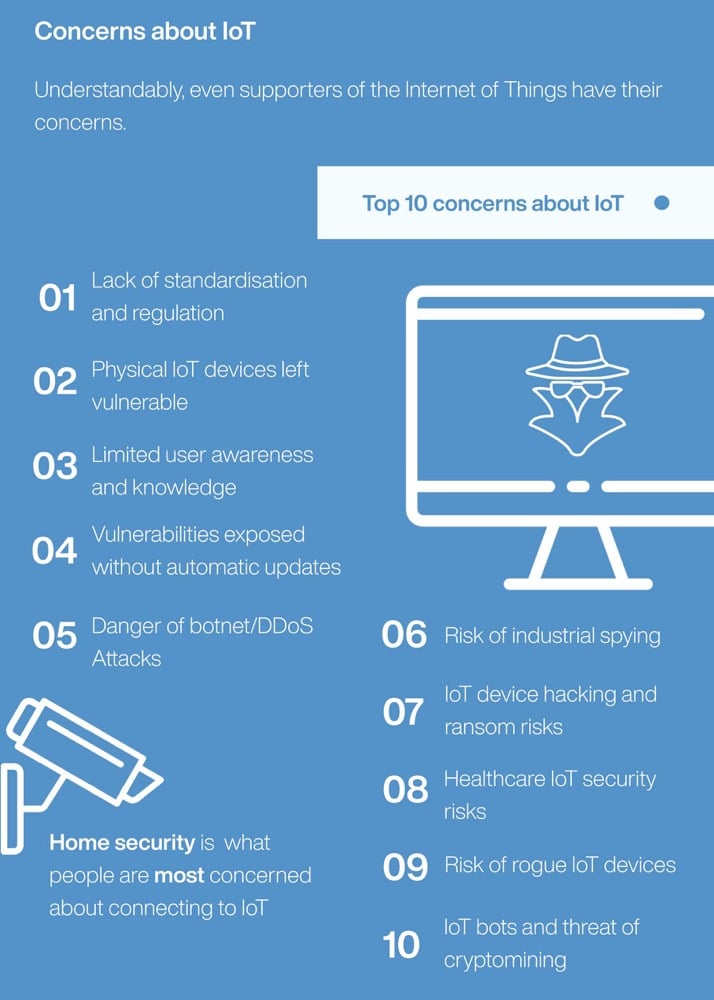
Understandably, even supporters of the Internet of Things have their concerns. In a world that is so intrinsically connected, the fear of hacks, leaks and misuse is ever-present. If one part of the network is compromised, it leaves many other connections at risk too.
When it comes to smart cities, there are vocal critics against ‘social optimisation’. There is also an obvious and very valid concern of IoT helping to create nanny states. Currently, Beijing is the most CCTV-surveilled city, with London topping the list of non-Chinese cities (it’s the ‘smartest’ city in the world, remember?)
Let’s take a look at some of the concerns about the Internet of Things and how you can mitigate some of them.
Top 10 concerns about IoT
The rapid development of IoT technologies and devices compared with very little regulation and standardisation has led to a number of concerns.
- Lack of standardisation and regulation
- Physical IoT devices left vulnerable
- Limited user awareness and knowledge
- Vulnerabilities exposed without automatic updates
- Danger of botnet/DDoS Attacks.
- Risk of industrial spying
- IoT device hacking and ransom risks
- Healthcare IoT security risks
- Risk of rogue IoT devices
- IoT bots and threat of cryptomining
IoT: cautionary tales
Let’s get deeper into three specific situations that are a major cause for concern for consumers and workers.
Big Brother in the office
A very understandable worry surrounding occupancy sensors is that it’s yet another form of CCTV keeping a close eye on our comings and goings, taking under-the-radar photos of people as they move about their workspaces.
It’s a very real problem, but the easy way to solve that one to ensure that you invest in people counting sensors that don’t send back images. We feel that way too, and so we only use sensors that send back 1s and 0s.
‘Alexa: help me rob this house’
When smart assistants such as Amazon’s Echo and the Google Home came on the market, opinion was divided. Was the automation they offered worth the security breaches they potentially posed?
Voice commands in particular can be worrying. Echo, for example, doesn’t have any voice recognition constraints, so in theory, anyone could stand near an open window in your house and command Alexa to ‘open the door’, or ‘turn off all the lights’, or ‘play Baby Shark on repeat’ – all terrifying prospects.
The good news?
The people who make the smart locks that can be linked to the likes of Echo have already thought of this issue, and provide a second layer of authentication, for example saying a PIN at the end of your command.
Ensuring these secondary levels of security are enabled should be enough to stop a burglar from entering via voice command.
Listening to every word you say: it’s child’s play

Perhaps the most insidious example here is the Cayla doll. Banned in Germany and labelled as an espionage device, the unassuming doll has a built-in microphone which listens to everything within a 25-30m radius.
This was most concerning to German officials, who fear that the children’s toy is vulnerable to external takeover.
Even worse, the doll sends everything it hears back to a company in the United States whose clients include intelligence agencies – and there is no notice of this on the doll or its packaging.
German authorities feel that this doll is pointedly endangering the ‘most vulnerable’ in our society: children.
The video below, made by the Consumer Council of Norway (Forbrukerrådet) helpfully sums up the problems with Cayla.
There’s not much we can say to make this one any better. Probably best just to avoid buying espionage devices for the kids in your life.
While it is undeniable that tighter regulations are needed, it is also clear that users need to educate themselves on how their data is being collected and where it is going.
IoT in numbers
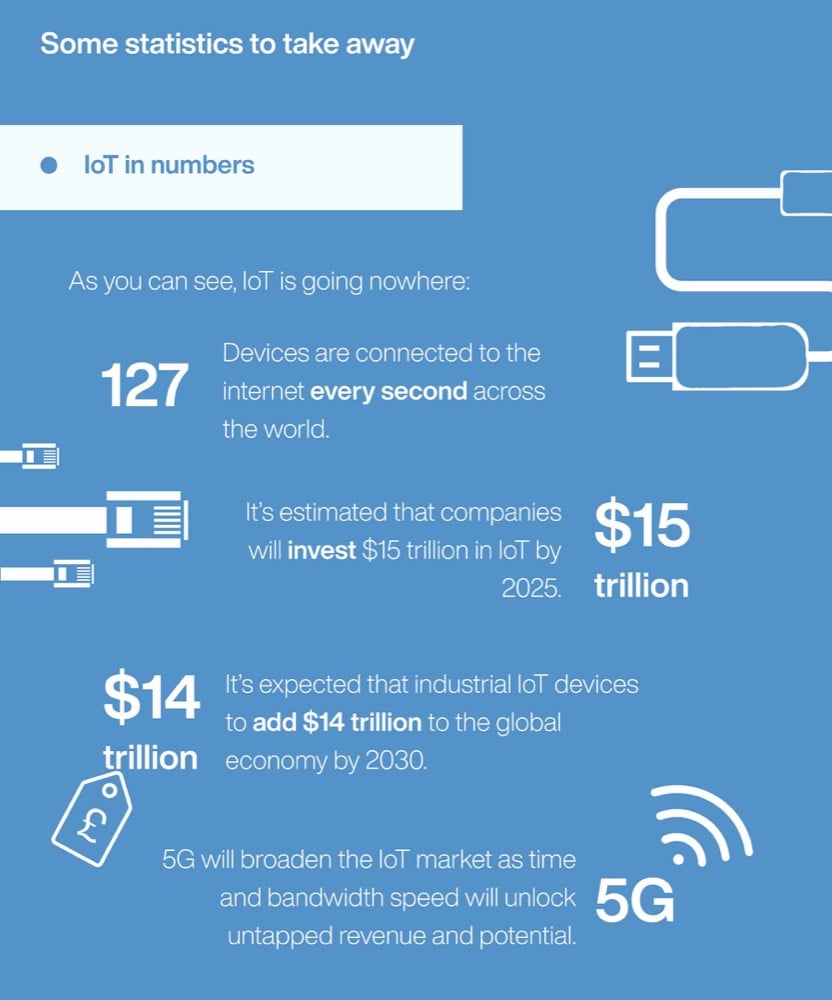
Before you go, take a look at these statistics about IoT. As you can see, IoT is going nowhere:
- 127 devices are connected to the internet every second across the world.
- The smart home global market is set to reach up to $53 billion by 2022.
- It’s estimated that companies will invest $15 trillion in IoT by 2025.
- 5G will broaden the IoT market in areas where time and bandwidth speed are crucial, unlocking untapped revenue and potential.
- Industrial IoT devices are expected to add $14 trillion to the global economy by 2030.
Find this article useful? Share on LinkedIn, Twitter, or email a friend.
Check out our IoT infographic here.

